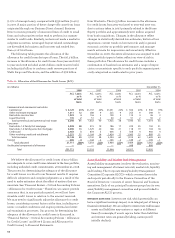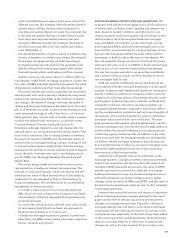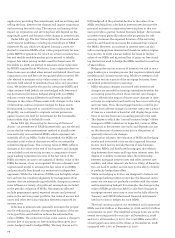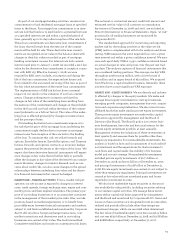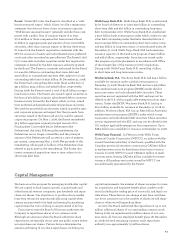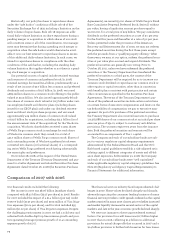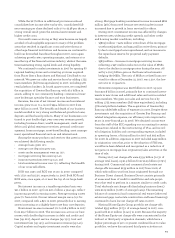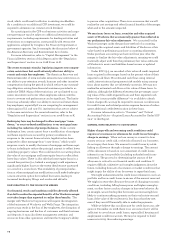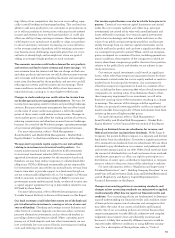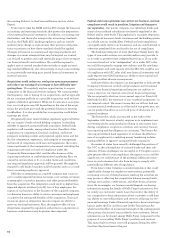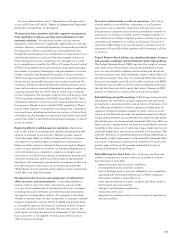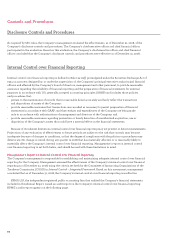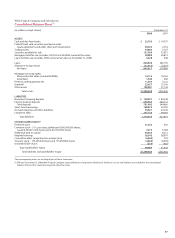Wells Fargo 2008 Annual Report Download - page 79
Download and view the complete annual report
Please find page 79 of the 2008 Wells Fargo annual report below. You can navigate through the pages in the report by either clicking on the pages listed below, or by using the keyword search tool below to find specific information within the annual report.
undertake to update them to reflect changes or events that
occur after that date that may affect whether those forecasts
and expectations continue to reflect management’s beliefs or
the likelihood that the forecasts and expectations will be realized.
In this Report we make forward-looking statements that:
• because loans subject to SOP 03-3 have been written down
to the amount estimated to be collectible, we expect to
fully collect the new carrying value of the loans;
• our 2009 pension expense will increase by about $600 million;
• securities guaranteed against loss by bond insurers are
expected to perform even if the rating agencies reduce the
credit rating of the bond insurers;
• until conditions improve in the residential real estate and
liquidity markets, we will continue to hold more nonper-
forming assets on our balance sheet as it is currently the
most economic option available;
• we expect that the amount of nonaccrual loans will change
due to portfolio growth, economic growth, portfolio sea-
soning, routine problem loan recognition and resolution
through collections, sales or charge-offs;
• to the extent the housing market does not recover, Home
Mortgage could continue to have increased loss severity
on repurchases, causing future increases in the repurchase
reserve;
• we believe that the election to measure at fair value new
prime mortgages held for sale and other interests held will
reduce certain timing differences and better match changes
in the value of these assets with changes in the value of
derivatives used as economic hedges for these assets;
• we expect changes in the fair value of derivative financial
instruments used to hedge outstanding derivative loan
commitments will fully or partially offset the changes in
fair value of the derivative loan commitments;
• we anticipate making capital expenditures of approxi-
mately $2.8 billion in 2009 for our stores, relocation and
remodeling of our facilities, and routine replacement of
furniture, equipment and servers;
• we expect that the proceeds from securities issued in the
future will be used for general corporate purposes;
• we believe the principal and interest on debt securities
held in the securities-available-for-sale portfolio are fully
collectible;
• management believes that the outcome of pending and
threatened legal actions will not have a material adverse
effect on our results of operations or stockholders’ equity; and
• we will not be required to make a contribution in 2009 for
the Cash Balance Plan.
In addition to the above forward-looking statements, this
Report states our beliefs and expectations about the adequacy
of our allowance or reserve for credit losses at December 31,
2008. There is no assurance that this allowance or reserve
will be adequate to cover future credit losses, especially if
credit markets and unemployment do not stabilize. As
described below and elsewhere in this Report and in our 2008
Form 10-K, increases in loan charge-offs or in the allowance
for credit losses and related provision expense could materi-
ally adversely affect our financial results and condition.
RISKS RELATING TO CURRENT ECONOMIC AND MARKET CONDITIONS
Our financial results and condition will be adversely affected if
home prices continue to fall and unemployment continues to
increase. Significant declines in home prices over the last year
and recent increases in unemployment have resulted in higher
loan charge-offs and increases in our allowance for credit losses
and related provision expense. The economic environment and
related conditions will directly affect credit performance. For
example, if home prices continue to fall or unemployment contin-
ues to rise we will likely incur higher than normal charge-offs
and provision expense from increases in our allowance for credit
losses. These conditions are adversely affecting not only con-
sumer loan performance but also commercial loans, especially
those business borrowers that rely on the health of industries
that are experiencing high levels of contraction.
Current financial and credit market conditions may persist or
worsen, making it more difficult to access capital markets on
favorable terms. Over the last year financial and credit markets
have experienced unprecedented disruption and volatility. These
conditions may continue or even worsen, affecting our ability to
access capital markets on favorable terms. We may raise additional
capital through the issuance of common stock, which could dilute
existing stockholders, or reduce or eliminate our common stock
dividend to preserve capital or in order to raise additional capital.
Participation in the Treasury Department’s Capital Purchase
Program restricts our ability to raise the common stock divi-
dend and may result in dilution of common stockholders. The
U.S. government has taken action to restore liquidity and stability
to financial and credit markets, including the enactment of the
Emergency Economic Stabilization Act of 2008 (EESA) and the
Troubled Asset Relief Program (TARP). As part of TARP, the
Treasury Department implemented the Capital Purchase
Program (CPP) to purchase senior preferred stock from qualify-
ing financial institutions including Wells Fargo. On October 28,
2008, we issued preferred securities and a common stock pur-
chase warrant to the Treasury Department under the CPP. Prior
to October 28, 2011, unless we have redeemed the preferred secu-
rities or the Treasury Department has transferred the securities to
a third party, the Treasury Department’s consent will be required
for us to increase our common stock dividend or repurchase our
common stock other than in connection with benefit plans con-
sistent with past practice. Under the anti-dilution provisions
included in the terms of the department’s CPP investment, the
per share exercise price of the warrant and the number of shares
of our common stock issuable upon exercise of the warrant will
be adjusted upon certain issuances of our common stock at or
below a specified price relative to the initial exercise price. The
exercise of the common stock purchase warrant could result in
material dilution to existing common stockholders.
Financial institutions that have received additional Treasury
Department investments through the CPP have been subject to
additional conditions, including the elimination of their common
stock dividend (or reduction to a nominal amount). Although we
do not anticipate a need at this time, there is no assurance that
we may not raise additional capital through the CPP. This could
result in the issuance to the Treasury Department of additional
preferred securities at dividend rates higher than the preferred
stock issued in October 2008, the issuance of additional common
stock purchase warrants, and even the issuance of shares of common



